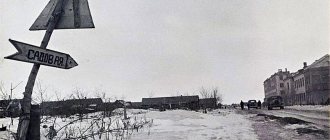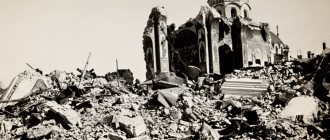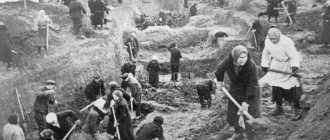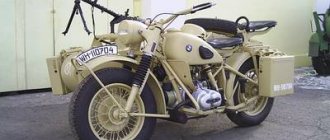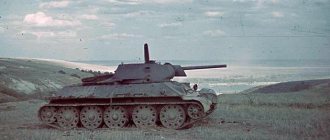1942 is a difficult stage of the Great Patriotic War . After the successful military operations of the Soviet army to liberate the territory of the Moscow region, a streak of failures . Bloody battles in the south of the country ended with the defeat of domestic troops and the loss of Crimea. The Wehrmacht captured the foothills of the Caucasus and reached the Volga. Here, in Stalingrad and its environs, the largest battle in world history , ending in February 1943 with the defeat of the forces of Nazi Germany . This event became a turning point in the war, and ensured that the Soviet troops seized the strategic initiative.
Brief historical overview
In a counteroffensive that began in December 1941 and continued until the spring of 1942, the Soviet army pushed the German invaders far beyond the Moscow region . As a result of victorious battles in the western direction, it was possible to liberate dozens of settlements captured by the Nazis and stop the rapid advance of the Germans deeper into the country. The Wehrmacht's plan for the lightning capture of the USSR was thwarted.
The success of the winter battles was replaced by a series of defeats caused by strategic miscalculations of the Supreme High Command, which believed that the main blow of the German troops would again be directed at Moscow. Between spring and autumn, German divisions occupied part of the southern territories . In May, the Nazis captured the Kerch Peninsula; in early July, after 9 months of heroic defense, Sevastopol fell. With its fall, control of Crimea passed into the hands of the enemy.
The army of Nazi Germany approached the North Caucasus and the Volga. The plans of the Nazi command included achieving in the summer of 1942 those goals that were not realized at the initial stage of the war due to the defeat near Moscow. It was planned to capture Stalingrad , enter the oil-bearing regions of the Caucasus and the fertile Kuban and Don lands. The fall of Stalingrad would have allowed the Nazis to cut off the southern territories from the center and capture an important waterway (Volga), along which cargo from the Caucasus regions was melted.
From July to November 1942 ( 125 days the Battle of Stalingrad lasted . In mid-November, a successful offensive by the Soviet army began, ending in February of the following year with the defeat of German formations . The turning point military battle changed the balance of power and allowed the Soviet command to dictate its line of war to the enemy.
Battle of Stalingrad
In December 1942, preparations were made for the operation to liberate the North Caucasus . (As a result of a successful offensive, by October 1943, domestic troops drove the Germans to the Kerch Strait and liberated the entire Caucasus region.)
Failures of the Russian Army
Suddenly, for the Soviet troops, the enemy was superior in both strength and numbers. Within three weeks, Lithuania and its neighboring states were occupied.
The Germans expected it to be an easy battle, but this did not work out. During the first weeks of the war, troops from Germany lost one hundred thousand people. But still, Germany had a superiority of forces compared to the USSR.
Civilians were also captured - they were driven to Germany and placed in concentration camps. Despite the losing position, the USSR managed to stop German troops on the approaches to the country's largest cities - Moscow, Leningrad and Novgorod. The battles for them continued until 1942. The Barbarossa invasion plan for the USSR was thwarted.
Dates of the most important events
The difficult stage of the wartime hard times included events demonstrating the heroism, courage and inflexibility of the defenders of the Fatherland, who defended every piece of Russian land at the cost of their lives and stopped the advance of the Nazi aggressors deep into their native country. The list of important memorial dates of 1942 includes:
- January 1 – liberation of the city of Staritsa (near Tver) from German invaders by units of the Kalinin Front.
- January 2 – liberation of the city of Maloyaroslavets.
- January 7-May 20 – Demyansk operation of units of the North-Western Front, which unfolded in the area of Demyansk (a village in the Novgorod region) with the aim of encircling and destroying the German corps of the “North” group. In April, the Nazis managed to break through the encirclement and create a corridor connecting the main forces.
- January 8-April 20 - Rzhev-Vyazemsk operation, carried out by forces of the Kalinin and Western fronts - an integral part of the general counter-offensive in the western direction with the aim of crushing the enemy group "Center". The bloody operation, which claimed the lives of about 780 thousand soldiers, was of key strategic importance. Domestic troops pushed the enemy back 200 km and completely cleared the Moscow and Tula regions and large areas of the Smolensk and Kalinin regions from invaders.
- May 8 - a breakthrough in the defense of the Crimean Front and the capture of the city of Kerch by a strike group of fascist troops, with the support of numerous German aircraft. By May 25, the Nazis took possession of the entire Kerch Peninsula.
- May 12-28 – The Battle of Kharkov, which began with the offensive of military units of the Southern, Bryansk, and Southwestern fronts and ended in a catastrophic defeat. Kharkov was surrendered. During the retreat, the united divisions suffered huge losses of personnel and could not successfully resist the enemy, who was rapidly advancing towards Voronezh and Rostov-on-Don.
- June 28-July 24 - Voronezh-Voroshilovgrad defensive operation, carried out by the forces of the Southwestern, Voronezh, Bryansk and Southern fronts. The combined divisions failed to repel the enemy offensive. The Germans moved the front line by 150-400 km, while capturing the right bank part of Voronezh and the city of Rostov-on-Don. The outcome of the hostilities created the preconditions for the movement of German armies to the Volga and Caucasus.
- July 4 - the fall of Sevastopol under the pressure of divisions of the army group "South", the German air force and Romanian corps. The invaders occupied Crimea.
- Summer-autumn - defeat of domestic troops in the Caucasian direction. On August 10, Maikop was surrendered, on August 11, the Germans took Krasnodar, and by September 9, all mountain passes were under the control of the invaders. The Soviet army suffered huge losses, but stopped the enemy. In December, preparations for a counteroffensive began.
- July 17-September 12 – the initial stage of the defense of Stalingrad. 12 divisions of the Stalingrad Front forced enemy units of the army group “South” to get bogged down in defensive battles on the outskirts of Stalingrad.
- August 23 – the beginning of intensive bombing of the city. Stalingrad is the only populated area in the world that was subjected to such a brutal air attack. For 4 days, six hundred fascist bombers carried out up to 2000 sorties daily, dropping tons of deadly cargo in a continuous stream. The city turned into ruins, the Volga burned due to spilled oil, and more than 40 thousand residents died.
- September 13-November 18 – the second stage of the Stalingrad defense. On September 13, Wehrmacht divisions broke through the defenses and reached the city center and the Volga. Soviet soldiers constantly carried out counterattacks, trying to recapture lost positions. Bloody battles were fought for every street, enterprise, and house. The heroic battle for Mamayev Kurgan (a bridgehead on the banks of the Volga), which passed from hand to hand several times, is known throughout the world. The defenders suffered huge losses (the personnel of each division of the 62nd Army was reduced to 700 people), but the city was not surrendered to the enemy.
- November 19 - the beginning of the counter-offensive of the Don, Stalingrad, and Southwestern fronts. The strategic offensive initiative developed in stages. From November 19 to 30 - encirclement of enemy formations near Stalingrad, December - continuation of the offensive and countering enemy attempts to open the ring. From January 10 to February 3, 1943 - cleaning up the encircled group.
Why did we retreat so quickly to Stalingrad in the summer of 1942?
The military campaign of 1942 for the Soviet command turned out to be no less catastrophic than the failures in 1941. After a successful Soviet counteroffensive in the winter of 1941/42 near Moscow, German troops were thrown back to the Rzhev area, but the threat to Moscow still remained. Attempts at a Soviet offensive on other sectors of the front were partially successful and did not lead to the defeat of the German armies.
Spring failure of Soviet counteroffensives
In order to weaken efforts and divert German funds during a possible attack on Moscow, three offensive operations were planned in the spring of 1942: on the Kerch Peninsula in Crimea, near Kharkov and near Leningrad.
All of them ended in complete failure and the defeat of the Soviet armies. Operations in the Crimea and near Kharkov were time-bound and were supposed to weaken the German forces on the Southwestern and Southern fronts and facilitate the release of Sevastopol. The operation near Kharkov was prepared on the initiative of front commander Timoshenko, and the Germans knew about its preparation. The German command, in turn, planned Operation Blau to seize the oil fields of the Caucasus and Caspian Sea and, in support of this operation, set the task of eliminating the Soviet Barvenkovsky salient with converging attacks from Slavyansk and Balakleya (Operation Fridericus). From this ledge, Tymoshenko planned to take Kharkov in pincers and capture it. As a result, in March-April 1942, in the Kharkov region there was a race to prepare offensive operations directed against each other.
Timoshenko launched the offensive first on May 12, but Kleist’s 1st Tank Army delivered a dissecting blow on May 17, and by May 23 the entire Soviet group found itself in the “Barvenkovo cauldron.”
The irretrievable losses of the Soviet army amounted to about 300 thousand people, there were also serious losses in weapons - 5060 guns and mortars and 775 tanks. According to German data, 229 thousand people were captured, only 27 thousand people were able to escape from the encirclement.
In Crimea, the Germans, on the contrary, were the first to go on the offensive on May 8, which came as a complete surprise to the front command, and within a week the Soviet troops were defeated and pressed against Kerch, which fell on May 15. The remnants of the Soviet troops ceased resistance by May 18. The total losses of Soviet troops on the Kerch Peninsula amounted to about 180 thousand people killed and captured, as well as 1,133 guns and 258 tanks. About 120 thousand military personnel were evacuated to the Taman Peninsula.
After the defeat on the Kerch Peninsula, the fate of Sevastopol was sealed, and after 250 days of heroic defense it fell on July 2. As a result of the evacuation of only senior command personnel, according to archival data, 79 thousand soldiers were abandoned in Sevastopol, many of whom were captured.
Unsuccessful Soviet operations in the south led to the loss of more than half a million personnel, a significant number of heavy equipment and a serious weakening of the Southwestern and Southern fronts, which made it easier for the German command to carry out the pre-planned Operation Blau for a strategic attack on the oil fields of the Caucasus and created the preconditions for withdrawal to Stalingrad and the Volga.
Near Leningrad, the Lyuban operation to relieve the city, which began in January, also ended in failure; the 2nd Shock Army under the command of General Vlasov fell into the “cauldron.” Attempts to break out were unsuccessful, and on June 24 it ceased to exist, with irretrievable losses amounting to more than 40 thousand soldiers.
Miscalculations of the Soviet command
The Soviet command believed that the Germans would attack Moscow in 1942, and concentrated their main forces in this direction.
In addition, the Germans successfully carried out Operation Kremlin to disseminate information about the preparation of an attack on Moscow and falsely transfer their reserves to this direction. German groups were seriously reinforced with fresh motorized and tank divisions, new 75-mm anti-tank guns and T-3 and T-4 tanks with long-barreled guns. No conclusions were drawn from the information obtained from the German plane shot down over Soviet positions on June 19, in which there was a German staff officer with documents on one of the stages of Operation Blau. The Soviet command assumed that the attack on Voronezh was a preparation for the attack on Moscow, since from Voronezh it was possible to advance north towards Moscow and south towards Rostov and Stalingrad.
Hitler decided not to attack Moscow, but rushed to the south and the Caucasus, and this had its own logic. The German army did not have enough fuel and needed Caucasian oil, since Germany’s own oil reserves were practically depleted, and its ally Romania did not have enough to supply the multimillion-strong German army.
Operation Blau
Operation Blau was multi-stage and envisaged an offensive on a wide sector of the front from Taganrog through Rostov and Kharkov to Kursk.
The defeat and destruction of the Soviet armies of three fronts was envisaged: Bryansk, South-Western and Southern. The delay of German troops in Crimea and near Kharkov only delayed the start of the operation by several weeks. To solve the tasks of the operation, two army groups were formed: the southern Army Group "A" under the command of Field Marshal List, which included the 17th Field and 1st Tank Armies, and the northern Army Group "B" under the command of Field Marshal von Boka as part of the 4th Panzer, 2nd and 6th Field Armies. The 8th Italian, 4th Romanian and 2nd Hungarian armies also took part in the operation.
Powerful tank wedges were supposed to break through and liquidate the Bryansk Front with the encirclement and destruction of enemy forces, then the capture of Voronezh and the turn of all mobile forces to the south along the right bank of the Don River to the rear of the troops of the Southwestern and Southern Fronts with the aim of encircling Soviet troops in the big bend of the Don with further development of success in the direction of Stalingrad and the Caucasus, covering the left flank of German troops along the Don River. The capture of the city was not intended: it was necessary to approach it within the distance of effective artillery fire in order to exclude it as a transport hub and center for the production of ammunition and weapons. At the final stage, the capture of Rostov-on-Don and the advance of mobile units to the oil fields of Maykop, Grozny and Baku.
Hitler also signed Directive No. 43 on July 1, which ordered the capture of Anapa and Novorossiysk by amphibious assault and further along the Black Sea coast to Tuapse, and along the northern slopes of the Caucasus Mountains to the Maikop oil fields.
Beginning of the German offensive
The German offensive began on June 28, the 4th Tank and 2nd German armies entered the operational space from the Kursk area.
They broke through the front, and at the junction of the Bryansk and Southwestern fronts a gap was formed about 200 km along the front and 150 km in depth, through which German tanks occupied the entire Kursk region and rushed to Voronezh. The Soviet command took this as the beginning of an attack on Moscow through Voronezh and sent two tank corps towards it. Between Kursk and Voronezh at Gorodishche, Soviet tank formations were met by powerful anti-tank artillery fire, and attacked from the flanks and rear by German tanks. After this battle, the tank corps ceased to exist, and the road to Voronezh was open.
On June 30, Paulus' 6th Army south of Voronezh also went on the offensive, supported on the left flank by the 2nd Hungarian Army and on the right flank by the 1st Tank Army. Paulus's army quickly reached Ostrogozhsk and threatened the rear of the Southwestern and Southern fronts.
By July 3, German tank crews broke into Voronezh, captured crossings across the Don and crossed it. By July 6, the right bank of Voronezh was captured by the Germans, and stubborn battles for the city began. The Germans failed to completely capture the city. Hitler decided that the 2nd Army would take it anyway, and on July 9 he sent the 4th Panzer Army south to encircle the Soviet armies in the Don bend. There were not enough forces to capture Voronezh, and the 2nd Army and part of the 2nd Hungarian Army were pinned down in the Voronezh area for a long time and could not move south.
At the beginning of July, a gap of several tens of kilometers appeared between the flanks of the Southwestern and Southern fronts, which there was no one to close. The German command sent mobile formations here and made efforts to encircle and destroy the main forces of the Southwestern Front, preventing their withdrawal to the east. For these purposes, Army Group “B” advanced from the north from near Voronezh with the forces of the 4th Tank and 6th armies, and from the south from the Slavyansk region, Army Group “A” with the forces of the 1st Tank Army in the general direction of Millerovo.
Headquarters ordered on July 6 to withdraw the troops of the Southwestern Front and gain a foothold at the Novaya Kalitva-Chuprinin line, but the front troops were unable to avoid being hit by tank wedges. The troops that went on the defensive on the southern bank of the Black Kalitva River could not withstand the blow and were simply swept away. The defense of the Southwestern Front collapsed, and German troops, not meeting resistance, marched east across the steppe.
Due to the deterioration of the situation, the Voronezh Front was created and strengthened on July 7, and the troops of the Southwestern Front received permission to retreat from the Donets to the Don in order to avoid encirclement. From the remnants of the Southwestern Front, the Stalingrad Front was created on July 12 and reinforced by three reserve armies - the 62nd, 63rd and 64th, and Stalingrad was placed under martial law. If the Germans had crossed the Volga, the country would have been cut up, deprived of Caucasian oil, and Lend-Lease supplies through Persia would have been threatened.
In order to stop the panic at the front, on July 8, Stalin issues the well-known order No. 227, entitled “Not a step back.” Each army created special barrier detachments to prevent retreat without orders.
"Kotel" near Millerovo
On July 7, the tankers of Paulus’s army crossed the Black Kalitva River and by the end of July 11 reached the Kantemirovka area, and the advanced formations of the 4th Tank Army, moving along the Don, reached the Rossosh area.
At the Vodyanoy farm, army groups A and B, moving towards each other, united, closing an encirclement ring in the Millerovo area on July 15 around the three armies of the Southwestern Front. The distance between the outer and inner rings was insignificant, and this allowed part of the troops to escape from the encirclement without heavy weapons. About 40 thousand people were surrounded, and the front lost almost all the heavy weapons that they managed to remove from Kharkov. The Soviet front in the southern direction actually collapsed, and there was a real threat of a German breakthrough to Stalingrad, the Volga and Caucasian oil. For the defeat in the Don Bend, Stalin removed Timoshenko, and General Gordov was appointed commander of the Stalingrad Front. In this catastrophic situation, the Headquarters ordered the commander of the Southern Front, Malinovsky, to withdraw troops beyond the Don in its lower reaches.
Throw south to Rostov-on-Don
After success near Voronezh and in the bend of the Don, Hitler decides to encircle and destroy the forces of the Southern Front in the lower reaches of the Don, for which he orders the 4th Panzer Army and the 40th Tank Corps to stop the attack on Stalingrad and move south to join the 1st Panzer army advancing on Rostov-on-Don, and Paulus's 6th Army was to continue the offensive towards the Volga. The Germans increased the pace of their offensive without encountering serious resistance in the steppe area; individual strongholds, pillboxes and tanks dug into the ground were quickly bypassed and then destroyed, the remnants of scattered Soviet units fought back to the east.
By July 18, the 40th Tank Corps, having covered at least two hundred kilometers in three days, reached the lower reaches of the Don and captured the important railway junction of Morozovsk. The threat of collapse loomed over the gates of the Caucasus - Rostov-on-Don: the 17th Army was advancing from the south, the 1st Tank Army from the north, and the 4th Tank Army was preparing to cross the Don and enter the city from the east. Tank formations reached the bridges across the Don on July 23, and on that day the city fell.
March to the Caucasus and breakthrough to the Volga
With the fall of Rostov-on-Don, Hitler considered that the Red Army was on the verge of final defeat and issued Directive No. 45, setting more ambitious tasks for the army.
So, the 6th Army was supposed to capture Stalingrad, and after its capture, send all motorized units to the south and develop an offensive along the Volga to Astrakhan and further, all the way to the Caspian Sea. The 1st and 4th Tank Armies were to move to the oil fields of Maykop and Grozny, and the 17th Army was to occupy the eastern coast of the Black Sea and capture Batumi. At the same time, Manstein’s 11th Army, which had captured the Crimea, was heading to the Leningrad region, and the SS tank divisions “Leibstandarte” and “Gross Deutschland” were heading to France. In place of the departed formations, the Hungarian, Italian and Romanian armies were introduced on the flanks of the Stalingrad Front.
Stalingrad was to be stormed by Paulus's 6th Army from the Don Bend and one of the tank corps of the 4th Panzer Army, which Hitler deployed and sent back to the north to speed up the operation to capture the city.
At dawn on August 21, infantry units in the Don bend crossed the river in assault boats, captured a bridgehead on the eastern bank, built pontoon bridges, and a day later the 16th Panzer Division moved across them to Stalingrad, which was only 65 km away. By the end of the day on August 23, the advanced tank battalion, on the way of which there were only heroically killed anti-aircraft gunner girls, having covered the distance from the Don to the Volga in one day, reached the right bank of the Volga north of Stalingrad, cutting off all communications. Subsequently, to supply besieged Stalingrad, it was necessary to build a railway along the left bank of the Volga. At the same time, German soldiers from one of the mountain rifle units hoisted Hitler’s banner on Elbrus, the highest peak in the Caucasus.
On a sunny and cloudless Sunday, August 23, German aircraft launched the most massive carpet bombing raid on the city on the Eastern Front against the vacationing residents of Stalingrad. It was turned into a real hell and almost completely destroyed; out of the 600 thousand civilian population and refugees, about 40 thousand people died. From that moment on, the heroic months-long defense of besieged Stalingrad began, ending in the German disaster on the Volga.
German troops were at the limit of their strength and capabilities, as they faced strong and unexpected resistance from Soviet troops, who did not flee in panic before a superior enemy, but stood to the death to hold it back. Hitler demanded an attack on the Caucasus and the Caspian Sea, for which the German army no longer had the strength. Excessively extended communications over hundreds of kilometers and the organizational and ideological weakness of the Romanian, Italian and Hungarian troops covering the German rear and flanks, well known to the German and Soviet command, made the operation to capture Stalingrad and the Caucasus adventurous.
The Red Army, having encountered Italian, Romanian and Hungarian allies of the Germans on a number of sectors of the front, drove them back and captured a number of bridgeheads that played a decisive role in the Soviet counteroffensive. The High Command of the Red Army was gradually recovering from the shock of the catastrophic defeats of the spring-summer of 1942 and was preparing to deal a crushing blow to the Germans at Stalingrad.
Battle of Kursk, battle of Prokhorovka and crossing of the Dnieper
July 5, 1943
The final turning point of the Great Patriotic War began - the Battle of Kursk.
, the largest tank battle in history took place near the village of Prokhorovka To date, it remains the largest such battle in world history. The mechanized units of the Soviet army won a major victory over the German troops.
No less significant in the turning point is the crossing of the Dnieper. The battle lasted four months. Tens of thousands of tanks, aircraft and other pieces of military equipment took part in it. As a result of these battles, a huge part of the territories that were under German occupation was liberated.
Beginning of the Battle of Stalingrad
By the spring
1942
, the priority of forces was on the side of Germany and its troops.
First, the Germans wanted to capture Crimea, and a few hours later the offensive began. At the end of spring it stopped for the Soviet troops too, it was tragic. In May, Soviet troops went on the offensive near the city of Kharkov and were again defeated. And again power passed to German troops. Fearing the loss of the entire Soviet South, Stalin issued an order called “Not a single step back.”
From
September 1942
, in broken Stalingrad, fights began in the streets.
But German troops failed to capture the city and even move on to a defensive plan. By the fall 1942
, the Germans occupied most of the European part of the USSR.
Plan "Bagration"
June 23, 1944
Operation Bagration began. In two months, Belarus, part of the Baltic states and Poland were completely liberated from Hiller’s Germany. On a front of 1,100 kilometers, the troops managed to advance 600 kilometers to the west.
Back to top 1944
Germany suffered huge losses, but was still a good opponent.
In January 1944
, the first large-scale attack on the enemy was carried out near St. Petersburg.
The blockade was missed and already in March
Ukraine was completely liberated, and the Red Army moved to the border of Montenegro.
In January 1945
, Soviet troops launched an early offensive on the German front to help their American enemies.
Defense of Leningrad
The most popular and tragic story in the Second World War was the defense of Leningrad.
Hitler's army was most eager to capture this city because it was a symbol of the
1917
.
Hitler thought that when Leningrad was captured, it would be a complete disaster for the USSR. 3
in this city before the war .
600
thousand people were evacuated.
On September 8 , the city was completely blocked on all sides.
It was a difficult ordeal due to the terrible cold.
The enemy hoped that people would be hungry and begin to destroy people themselves. But the Soviet people, on the contrary, rallied. More than a million people died during this terrible period. Only in January 1943
was the blockade broken and the import of goods and products into Leningrad began. The Red Army not only survived, but also began to move in to capture the capital.
